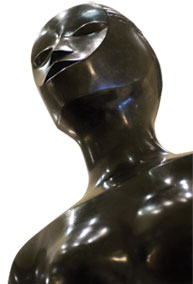 Elizabeth Catlett
Elizabeth Catlett (American, b.1915, d.2012)
Stepping Out, 2000
Iowa Memorial Union, Hubbard Commons
bronze
The first African-American MFA student to graduate from the UI, Elizabeth Catlett, 40MFA, chose this work specifically to emphasize the university's early acceptance of women scholars and focus on racial diversity.
My images are objects upon which to reflect and consider who we are and how we got to be like this."
UI professor emeritus Peter Feldstein offers this explanation of the creative impulse behind one of his latest projects. But, his words also sum up the ambitious goals of the UI’s Art on Campus program, which showcases Feldstein’s Iowa Portraits—photographs of ordinary Iowans etched on immense glass panels—that were recently installed in the new College of Public Health building.
Under this 30-year program, dozens of public works of art are scattered around campus in places where people can enjoy and interact with them. Removed from the formal surroundings of a museum, they invite a meditative moment, a second look, or a caressing touch.
“Great art mesmerizes people,” says UI Museum of Art Director Sean O’Harrow, who chairs the Art on Campus committee. “This program puts that kind of art into people’s daily lives, inviting spontaneous, unplanned learning.”
The UI program is part of the state of Iowa’s Art in Public Buildings initiative, which since 1979 has mandated that all state-funded buildings must set aside half of one percent of total project costs for art. That may not sound like much, but it’s created an incredible public art collection on the UI campus.
In concrete, bronze, paint, mosaics, glass, wood, pottery, and other media, artists express their visions. And the public responds. Outside the football stadium, fans pose for photographs with the bronze statue of Nile Kinnick. At the Campus Wellness and Recreation Center, a steady stream of visitors walks along the 50-foot-long River of Life mosaic that meanders along the floor of the entrance hall. Near the Chemistry Building, people trace the intricate maze carved into the 19-ton granite boulder called Ridge and Furrow.
Here, Iowa Alumni Magazine showcases some of the works of public art that offer such opportunities to pause, to reflect, and to learn what makes us human.
 Peter Feldstein (American, b.1942)
Peter Feldstein (American, b.1942)Iowa Portraits, 2012 College of Public Health Building
Photo-etched images on glass
Peter Feldstein's portraits of people from throughout the state represent all the Iowans served by the UI College of Public Health, either directly or indirectly. Their quiet beauty offers a human presence to a building devoted to science and medical research.
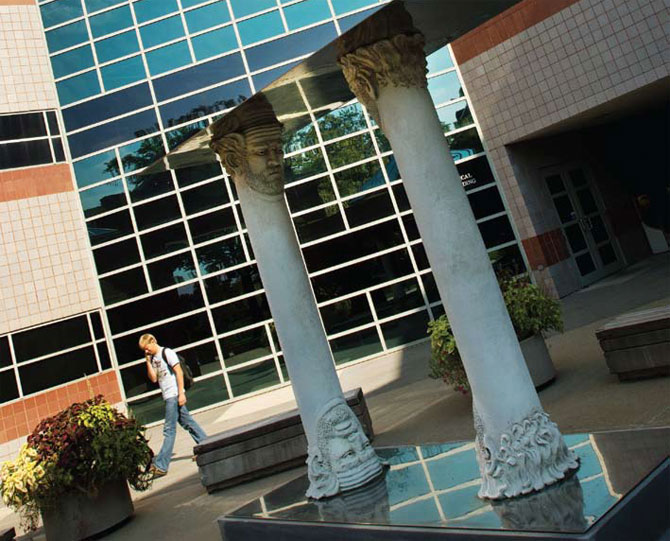 Robert Arneson (American, b.1930, d.1992)
Robert Arneson (American, b.1930, d.1992)Gateway to Self Realization, 1992
Eckstein Medical Research Building, west courtyard
painted bronze, stainless steel
Sculptor Robert Arneson suffered from cancer, an illness that eventually claimed his life but did not dim his belief—as expressed in this work—that each individual is charged with the responsibility of self-knowledge.
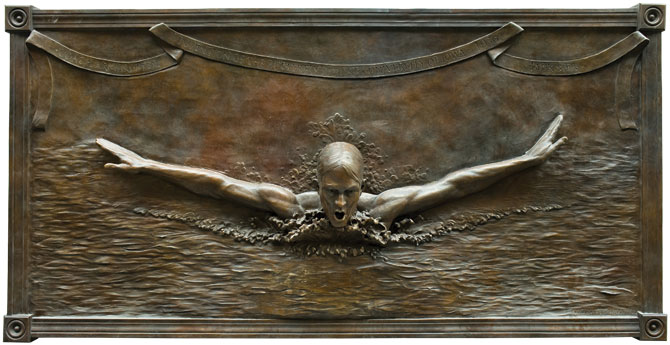 Lawrence Nowlan (American, b.1965)
Lawrence Nowlan (American, b.1965)Swimmer, 2009
Campus Recreation and Wellness Center, second floor pool entrance
bronze high relief 4'x7'
Here, Lawrence Nowlan immortalizes former Hawkeye swimmer Jack Sieg, 36BSE [deceased], who helped coach David Armbruster, 20BA, 31MA [deceased], refine the butterfly stroke he invented at the UI. The bronze relief deliberately harkens back to the 1930s in its style, commemorating a hero from UI history while inspiring current student-athletes to further greatness in competition.
 Sharon Roadcap-Quinlivan (American)
Sharon Roadcap-Quinlivan (American)Untitled, 2002
Karro Athletic Hall of Fame, east windows
custom-laminated glass panels (16) 135"x96"x1"
Sharon Roadcap-Quinlivan used stylized representations of athletes to indicate the various sports offered at the UI.
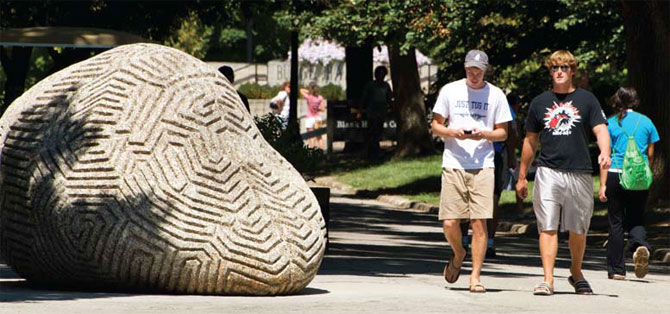 Peter Randall-Page (British, b.1954)
Peter Randall-Page (British, b.1954)Ridge and Furrow, 2011
Cleary Walkway
19-ton carved granite boulder
In this work, Peter Randall-Page embraces an organic pattern found in many natural forms—from the structure of the human brain to a tiger's stripes and to the plowed fields that cover much of Iowa. The granite boulder he used for this work is similar to those deposited in Iowa by prehistoric glaciers.
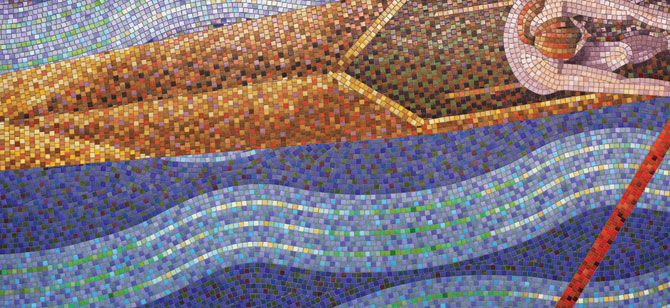 Rebecca Ekstrand (American, b.1950)
Rebecca Ekstrand (American, b.1950)Calm Waters, 2010
Beckwith Boathouse, Rowing Tank Room
glass-tile mosaic 42'x5'
As artist Rebecca Ekstrand is involved in rowing, she knows the physical demands of this intense sport. With this mosaic, she wanted to lift the spirits of the Hawkeye rowers during long, arduous hours of repetitive practice indoors.

